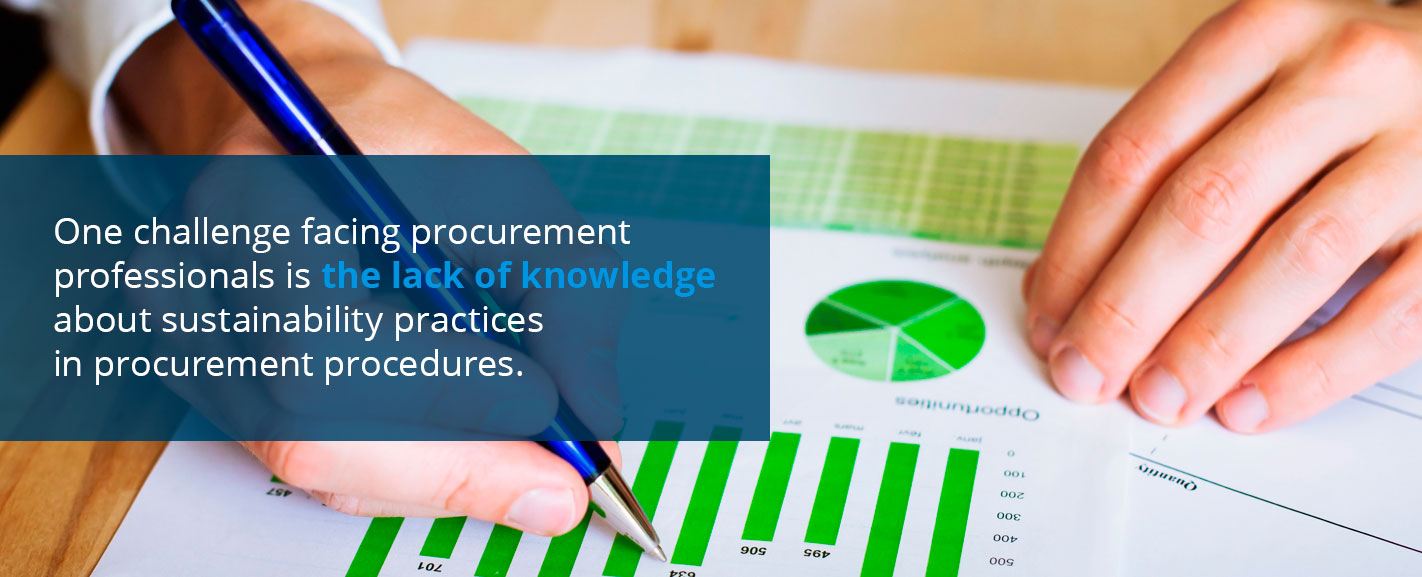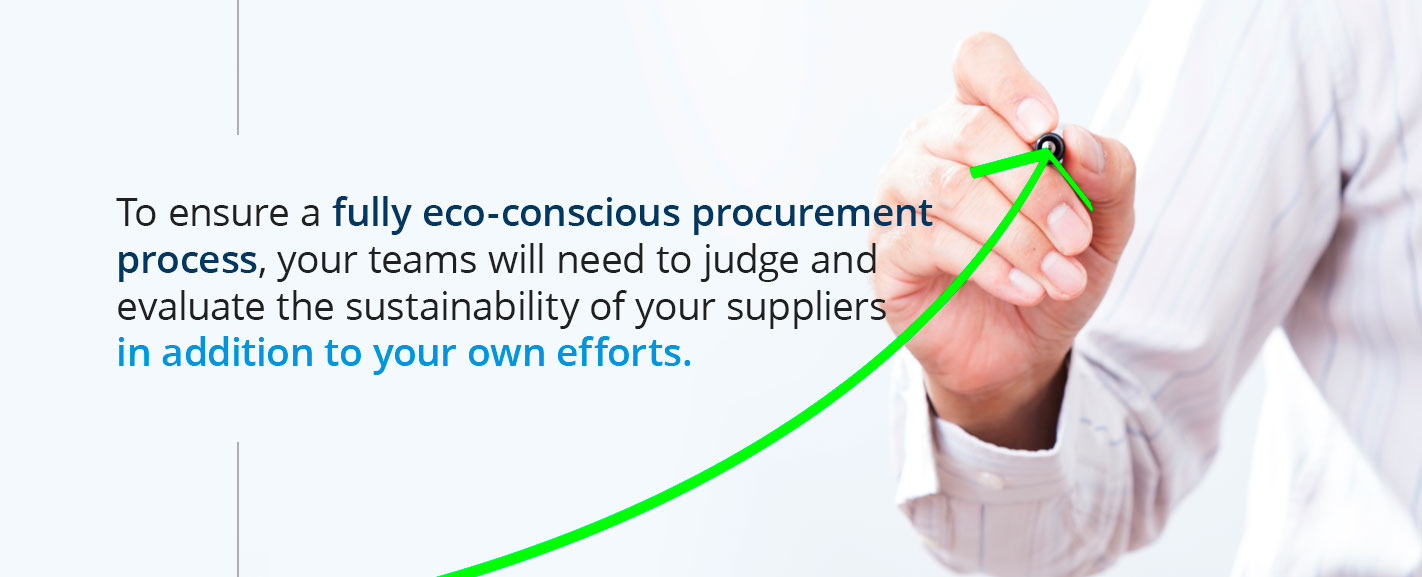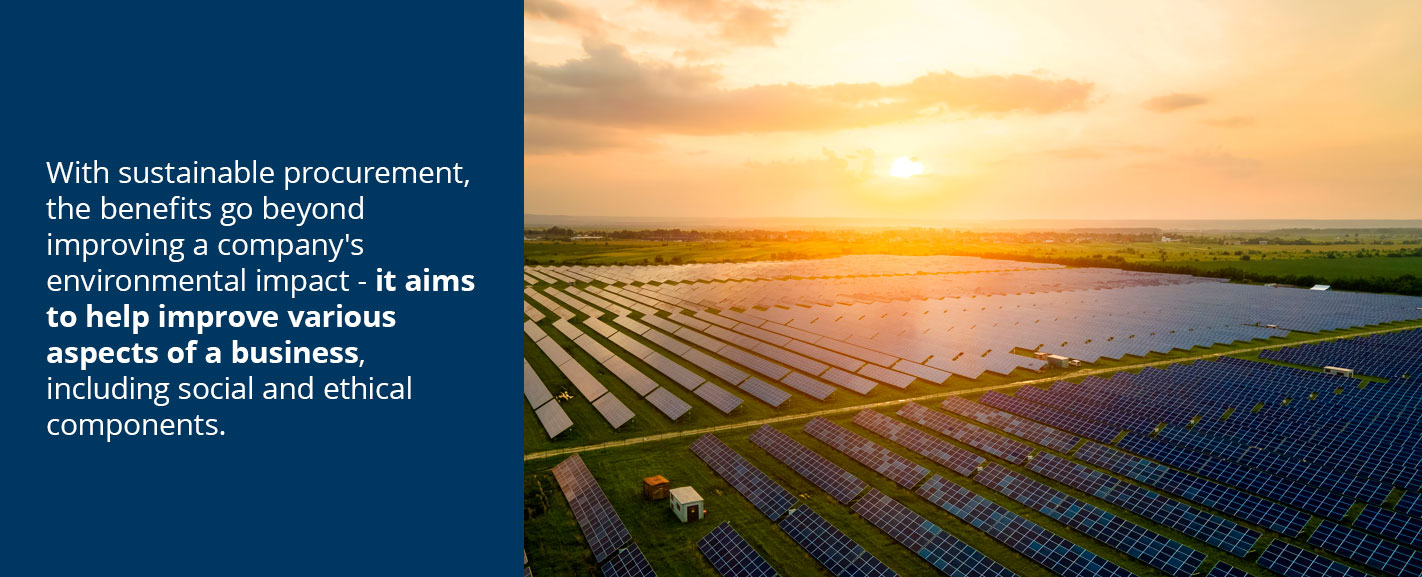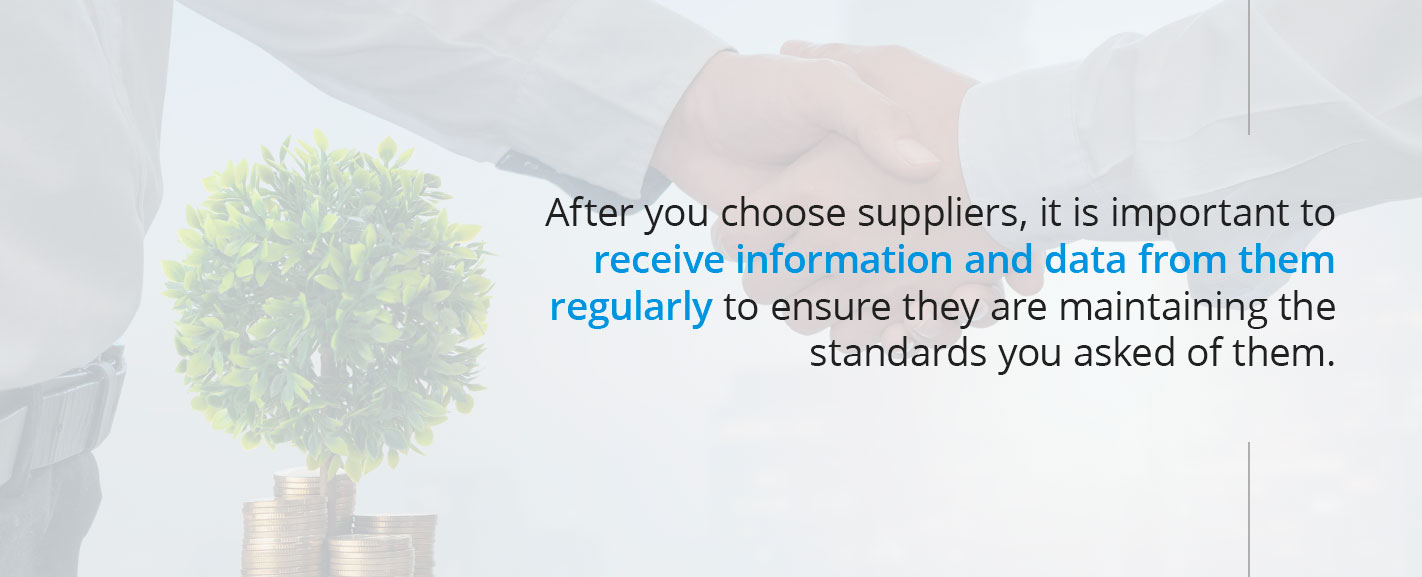6 Challenges of Sustainable Procurement
Last updated: November 9, 2021
Many companies want to switch to more sustainable and environmentally friendly tactics to reduce their impact on the environment. With sustainable procurement, businesses can tackle their sustainability goals at the supply and procurement levels in their product processing.
However, despite the many important drivers of sustainable procurement, numerous challenges can prevent procurement teams from switching to more sustainable methods. Explore them more in-depth with this article.
What Is Sustainable Procurement?
Sustainable procurement is a method of obtaining supplies through environmentally, economically and socially conscious methods while still meeting government regulations. Many procurement, sourcing, purchasing and supply chain departments seek more sustainable practices to better their environmental impact in a way that goes beyond recycling efforts.
This procurement method can take on many different forms for companies, including:
- Closed-loop supply chain (CLSC): In a CLSC, companies aim to practice sustainability at all levels of a product's life cycle, from manufacturing to retiring. Companies may procure items from suppliers that use recycled or repurposed materials to reduce the environmental impact of making and buying those products. Further, businesses also offer repairs or recycling programs to lengthen the life of their products or dispose of them sustainably.
- Ethical procurement: With ethical procurement, procurement departments monitor and evaluate the ethical practices of their suppliers to help meet their own goals. Policies like unsafe working conditions or corruption within the supplier's company may interfere with a procurement team's ethical goals and lead them to seek a supplier with a more humane approach. Ethical procurement can include various conditions, including labor and human rights policies.
- Reverse supply chain: Also called reverse logistics, the reverse supply chain is a specific cycle in the CLSC where products return to their supplier for repairs or recycling. Companies using a reverse supply chain urge people to invest in repairs for their products instead of throwing them out. They also encourage consumers to return products to the company when they no longer want them to keep these items out of landfills. IKEA is at the forefront of reverse logistics, selling individual parts for repairs and lightly used furniture at discounted prices.
- Triple bottom line (TBL): When selecting procurement methods under TBL, procurement professionals judge and choose techniques based on environmental, societal and financial factors. This method aims to combine the focuses of many procurement teams to find a procurement approach that can optimize the company's effects on its employees and the planet while reducing costs.
The various options for sustainable procurement allow companies and procurement teams to find a method that best suits their interests and sustainability goals.
Challenges Facing Procurement Professionals

When considering whether to incorporate more sustainable procurement methods into your enterprise, keep in mind these six common concerns that professionals encounter:
1. Lack of Knowledge About Sustainability
One challenge facing procurement professionals is the lack of knowledge about sustainability practices in procurement procedures. This issue can arise in all levels of a company, including procurement management departments that are unsure how to proceed and shareholders who are uncertain of the benefits sustainable procurement can provide.
This lack of understanding may also manifest in managers being unclear about how to sustainably procure supplies or best evaluate the eco-friendliness of their current process. To optimize sustainability at the procurement level, businesses need a team that can accurately process and analyze relevant data throughout procurement. Many procurement managers and directors may not know how to collect this data.
When dealing with a lack of sustainability knowledge, the best thing you can do is advocate for education and training courses to prepare and teach your team and other relevant employees about the importance and process of sustainable procurement. Training courses allow you to outline how essential sustainable procurement is and highlight skills your team members will learn from investing in this method.
2. Few Internal Resources
Time, funding and other resources are essential in ensuring the best results from your sustainability efforts. Procurement teams need time to learn the processes necessary to carry out sustainable sourcing and purchasing habits. They must learn how to evaluate the sustainability of their performance and their suppliers' performance.
Further, when implementing sustainable practices, it takes time to work toward the desired results. Sustainability isn't achievable overnight, so many businesses feel they don't have the time to wait for it to take hold when they have other, more immediate methods. However, like other resources, time is an investment that will allow your procurement team to grow and adopt new skills and practices that are better for the environment.

3. Little Support or Pushback From Suppliers
To ensure a fully eco-conscious procurement process, your teams will need to judge and evaluate the sustainability of your suppliers in addition to your own efforts. Because suppliers are separate from your company, they may have different values or resources available and might not be open to a new approach. Further, they may not know how to obtain the appropriate data you need to evaluate their efforts.
It is best to deal with suppliers after your procurement team has settled into its new sustainability practices. Afterward, you can share information and techniques with your suppliers to help them better calculate their sustainability, such as programs or courses they can use to learn the necessary skills. Like your company shareholders, suppliers may not understand or know the importance of sustainability, so appealing to them can educate them on the benefits of this practice.
When switching to more sustainable procedures, you can also look for suppliers who have already implemented an eco-friendly supply process. While this can be costly for enterprises already using reliable suppliers, this option can help those searching for new suppliers of a certain product.
4. Lack of Government Funding or Cultural Support
While internal factors can play a large role in determining how sustainability looks at your company, many external circumstances can be challenges for sustainable procurement, like government funding, cultural support or even politics. Some cultures may be more open to sustainability efforts than others, and they may have additional backing from their governments and politicians to advocate for greener habits.
For example, in a study that ranked all countries on their sustainability efforts, 19 out of the top 20 countries were European, and the top three were northern or Scandinavian countries. Because European nations and governments tend to value sustainability efforts, companies in this continent have an easier time ranking higher overall than other businesses in continents with less support.
Lack of environmental support provides fewer incentives for businesses and procurement departments to switch to sustainable methods. However, corporations can influence cultural mindsets on platforms like sustainability. Brands and companies can pave the way toward change by setting sustainability standards others can follow.
5. Higher Costs
When approaching a more sustainable procurement method, many procurement departments and companies worry about the cost of switching to a new process. In a study that asked about national legislative support, 97% of companies reported that the lack of supporting government policies would lead to an increase in costs for their projects.
Whenever companies change protocols or procedures, there will be a period where expected costs change. After switching to sustainable procurement, 38% of companies saw increases in their expenses. However, when considering the switch to sustainable procurement methods, think of it as an investment for the future of your company and the planet.
Further, even though this form of sustainability is at the procurement level, many of the challenges facing procurement professionals come from not utilizing all the resources available at their company. Other departments, like finance, can help with various challenges and facilitate interaction between departments when they otherwise wouldn't.
6. Difficulty Accessing Proper Technology
When deciding to make the procurement process more sustainable, many procurement managers and departments find they need a different set of tools or technologies to efficiently make their efforts environmentally friendly. Further, these tools need to easily integrate into current systems for a streamlined procurement process.
Depending on funding and upper-level internal support, new technology can be hard to achieve. However, providing education across various levels of your company and calling for more emphasis on the importance of sustainable practices can help other departments better understand and see the need for sustainable procurement.
New tools and technologies require training, which may take time away from procurement specialists. However, this training provides you and your team with specialized skills that will optimize your sustainable procurement efforts and allow you to advance in the field.
Benefits of Sustainable Procurement

Even though there are many challenges facing procurement professionals with sustainable procurement, this method can provide many benefits across several levels for businesses and suppliers:
- Better your branding: When you switch to sustainable practices, you can report those practices and the improvements they caused to your customers, marking yourself as an eco-friendly brand. Those who care deeply for the environment will trust your company and practices by knowing you are a green brand.
- Reduce greenhouse gases: About 13% of U.S. greenhouse gas emissions in 2019 came from businesses and homes — 23% were from industry. By switching to sustainable procurement methods, you reduce your greenhouse gas emissions and enable less carbon to be released into the environment.
- Decrease energy costs: Sustainable procurement allows you to use energy efficiently, allowing lower overall energy costs across the procurement process. Lower energy usage can help balance costs and save your company money long term, especially if you need funding or training for these new processes.
- Support human rights: When procuring your supplies, you can better your ethics by purchasing from organizations that uphold workers' rights. Some suppliers might use child or slave labor when manufacturing their products, but by using a sustainable procurement method, you can evaluate the sustainability of companies based on their ethical practices during production.
- Affect multiple environmental issues: With sustainable procurement, your company can help the environment in numerous ways. When you use eco-conscious business practices, especially procurement, you can help increase biodiversity, decrease water pollution and save at-risk habitats. Further, by reducing harmful environmental factors, human health can improve.
- Increase employee specialization: Through training and education programs to help teach necessary skills and the importance of sustainable procurement, employees across departments can gain new and specialized skills that set them apart from other workers in your industry.
- Improve your supplier diversity: Because sustainable procurement involves evaluating and rating the sustainability efforts of suppliers, procurement professionals can expand their search for suppliers and open doors for more diverse partners. Additionally, local suppliers often use sustainable practices, and procurement can help support local supply branches.
With sustainable procurement, the benefits go beyond improving a company's environmental impact — it aims to help improve various aspects of a business, including social and ethical components. When investing in sustainable procurement, your efforts affect the entire enterprise.
Steps for Sustainable Procurement
When considering using sustainable procurement measures at your company, you can take steps to begin implementing greener purchasing habits:
1. Address Where You Can Apply Sustainability Measures
After choosing to procure products sustainably, procurement teams must first study product usage across the company and determine areas where they can apply more eco-conscious practices. This might mean swapping current items for reusable options or ones made from recycled materials. Identify any areas of high waste and brainstorm how sustainable procurement might help there.
2. Determine Your Sustainability Requirements
After you decide where sustainability will fit into your company, establish how those green practices will mesh with local governmental standards and your operational requirements. Be sure to set both minimum and desired requirements so you can use that information as a guideline when evaluating supplier performance.
3. Assess the Performance of Potential Sustainable Suppliers
As you determine which suppliers to use, use the sustainability model you created in step two and apply those standards to suppliers to see which ones meet your specifications.

4. Receive Feedback and Updates From Suppliers
After you choose suppliers, it is important to receive information and data from them regularly to ensure they are maintaining the standards you asked of them. You can ask for this data in annual or quarterly reports or however often fits your operations.
5. Reflect on and Improve Your Sustainability Habits
While ensuring supplier performance is important, you should also regularly assess your own data to judge how you are meeting your sustainability standards. By doing this, you can identify any areas where you are meeting your minimum or below-minimum requirements to continue to strive toward your desired sustainability levels.
As you evaluate your performance, you can track and publish your progress so others can see how you are actively working to become a more sustainable brand.
Trust Dryden Group With Your Department's Sustainable Procurement
While sustainable procurement has its challenges when initially integrating and implementing changes into the procurement process, companies can receive long-term benefits on both small and large scales. With sustainable procurement, you can rest assured knowing your green efforts will reap significant advantages.
At Dryden Group, we are an organization for indirect procurement, helping you manage your entire indirect procurement portfolio. We can offer specialized aid across numerous industries, promising you the best care. Contact Dryden Group today and discover how we can help you with your sustainable procurement needs.